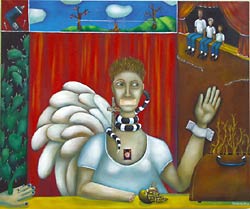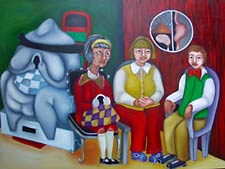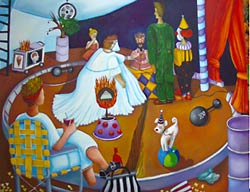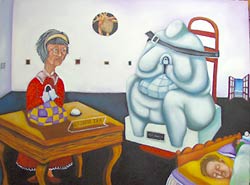FYIs: The average American woman is 5 feet, 4 inches tall, weighs 140 pounds, and wears a size 14 dress. A "leitmotif" is a motif or theme associated throughout a music drama with a particular person, situation, or idea.
The Art of Obsession
Kim Brebes’ Paintings Reveal Her Inner Demons, Borne of a Culture Obsessed With Weight
BY GLEN STARKEY
Like a lot of women, Kim Brebes thinks she's fat. She's filled with self-loathing, disgusted by her own body, and unable to come to terms with her weight. Her obsession touches her life in too many ways.
She can't stop painting about her weight-obsession dreams. Her health has been affected too. Brebes actually gave herself a heart attack from ingesting too many diet pills.
"I'm sad," said the mother of two kids–ages 9 and 11–matter-of-factly. "When my kids were little, I didn't want them to know how weight-obsessed I am. Now they know I'm freaked about my weight and that weight is important."
This month Brebes will display her weight-obsession paintings at Art Lives Here, and during the opening reception she will sleep in the gallery, under the influence of sleeping pills, while people walk around looking at her and her work.
If this sounds absolutely crazy to you, you're not alone in your assessment. Brebes is quick to admit she's sick.
"I was taking Prozac for 10 years, and then I found out it makes you gain weight, so I quit and now I'm even more mental."
A lot of great artists were messed up in the head. Picasso was a shameless solipsist and misogynist womanizer; Van Gogh a mentally ill self-mutilator; Schiele a practitioner of incest; Pollack an alcoholic and vicious wife beater; Modigliani, Basquiat, and many others incorrigible drug addicts.
In comparison, Brebes' weight obsession might seem pretty minor, but it's indicative of a nationwide phenomenon in our culture, where from an early age women are conditioned to believe self-worth and happiness are directly connected to body image.
"It's impossible for a man to ever completely understand this issue," said Heidi Harmon, a close friend of Brebes who recently lost 60 pounds herself. "I try not to talk about it much because I just can't take it anymore. For most women, it doesn't matter what's going on in their life, how great it is or challenging, their body is at the center of it. I was dealing with this myself.
"I've got a great life, a wonderful husband who loves me, beautiful, healthy children, and I have a lot to offer," Harmon continued. "But when I was heavy, I was a mother but a fat mother; I was creative but a fat creative person. When you're fat, or even when you're just not thin, which is really what it is, you become invisible. I think that's why a lot of women do overeat: They want to be invisible. They have something difficult to deal with, so they hide behind the weight."
For the record, Brebes, 32, is not obese. She's 5 feet, 4 inches tall and weighs around 150 pounds. She's bubbly and fun to be around, has a wicked sense of humor, is a very talented artist and a wonderful mother and wife, and has a lot of close friends. She also can't stop freaking about her weight.
"I know I'm sick, but why can't I be sick enough to become anorexic?" she lamented. "I even tried throwing up, but I just couldn't do it. Deep down, I think I don't know how to like myself. When I'm fat I always think, 'Oh, my life would be so much better if I could get thin.' I've lost weight before, and I stay thin for a couple months, then I put the weight back on because being thin isn't exciting anymore. Part of me wants to be sick. So I take it off and put it back on and take it off again and put it on again. The reason is because I'm used to being sick. That's more comforting."
Is Brebes conscious of the fact that anorexia is just another form of sickness?
"Yes, but at least you look good when you're thin."
"Thinness is so much more glamorous and socially acceptable, but it can be a disease too," said Heidi Lewin-Miller, a local licensed marriage and family therapist who specializes in eating disorders. "So many overeaters and bulimics say they wish they were anorexic. It's very disturbing.
"And this comfort in her sickness is very, very common. The way so many of my clients talk about it is that it's familiar, they know what to expect from other people's reaction and the world. Being thin often brings them too much unwanted attention."
Brebes' obsession certainly isn't unique. Millions of American women are dealing with the same thing right now. According to Cambria resident Vikki Hansen, a licensed clinical social worker and author of "The Seven Secrets of Slim People," Brebes' condition is all too common.
"In this culture, in America, it's the only place in world where there's a huge weight problem," said Hansen. "Seventy-five percent of the population is overweight, and one-third clinically obese. The average woman is 5-feet, 4 inches tall, weighs 140 pounds, and wears a size 14 dress.
weight problem," said Hansen. "Seventy-five percent of the population is overweight, and one-third clinically obese. The average woman is 5-feet, 4 inches tall, weighs 140 pounds, and wears a size 14 dress.
"One-third of women wear a size 16 or larger. That's interesting when you consider that Marilyn Monroe wore a size 16. That's how much the standards of beauty have changed. Today a size 2 or even a size 0 is considered the standard. It's a profound plague, a national epidemic–whatever you want to call it–and it causes women to dehumanize themselves."
The Root of the Problem
According to Hansen, weight obsession is borne of our very socialization processes.
"Take a look in any women's magazine and you'll find that every article has to do with outer appearance: hair, makeup, face, how to please others, how to please your man in bed," said Hansen. "In one out of 30 magazines you might find one article about making yourself happy.
"What happens is, we as women focus on weight and try to control our weight into order to be more successful, but we end up creating a weight problem where one wouldn't otherwise exist.
"If [Brebes] would just listen to her body, if she could learn how to do that again, she would melt down to her normal body size and stay there. It's perfectly natural.
"Think about an infant. Infants don't eat when they're not hungry. In fact, every animal refuses to eat except for one reason: physical hunger. But the minute we understand language, we begin to be conditioned: clean your plate; no dessert until you eat your peas; finish your dinner because there are starving children in China, in Africa."
From there, according to Hansen, women learn about dieting in adolescence, which begins a process of deprivation, disconnection, and lack of control over the body. Food turns into an obsession.
"This is a national plague," said Hansen. "Now we have 75 percent of women who hate their bodies. Fifty percent of women in this country are on a diet at this very moment. Think about that."
Dr. Cass Ryan, a professor of human ecology, published an article dealing with weight obsession, "Rethinking the Thinness Obsession," in the Journal of Family and Consumer Affairs, that offers some startling facts about women and dieting. For instance, females as young as 5 years old are dieting. The magazine also reported that the Turner Broadcasting Co. has placed a weight limit on the people they put on television.
"There are 5-year-old girls who will not put on tights and a leotard because their stomach protrudes. At five, your stomach is supposed to do that," said Ryan, who also suggested that weight obsession didn't start until the 1960s, when the ultrathin model Twiggy became popular.
According to Ryan's article, the media's idea of an ideal female body is taller than 5-foot-9, but weighing less than 120 pounds. She points out, however, that only 5 percent of the female population can possibly attain that look.
Is it any wonder so many women are filled with feelings of inadequacy and self-loathing?
The Paintings
Brebes is fond of self-analysis. She's always trying to interpret her dreams and her paintings.
Recalled Brebes: "One early morning in the stage between sleep and awakening, this poem came into my head: ‘Take a walk around my garden. Time has nurtured many weeds. Mother slumber kept her blinded, from the planting of the seeds.’
"In some way I think these paintings are a garden of my sickness. But I really don't want to paint about this anymore. It's pathetic. I feel like this is going to kill me. In one way or another this is going to kill me."
Since the paintings are from her dreams, Brebes likes the idea of sleeping through the opening, which will be videotaped, and watching the tape later, like a dream for her.
"The idea of me laying asleep while people walk around the gallery looking at my paintings is funny to me. I'm going to have taken sleeping pills, but tell people anyway to please not try to wake me up."
Brebes' colorful and cartoony style belies dark subject matter, and it's not uncommon to find such recurring leitmotifs as a heart, a snake, rain clouds, and familiar characters.
"There are two figures that have been showing up for years," said Brebes. "All these [images] were dreams, and there's always a fat woman and a thin woman. Usually the fat woman is dominant over the thin. I haven't completely figured out why I keep dreaming about them. Maybe it's symbolic for two sides of myself that I haven't been able to reconcile.
"How much time did I put into painting about [my weight obsession] and worrying about it over and over?" asked Brebes rhetorically. "I don't want to paint about it anymore after this [show]."
Another painting shows a mother with two adult Down syndrome children, which Brebes thinks reflects her lack of confidence in her intellect.
Brebes has yet to interpret other elements in the paintings.
"A lot of it I don't get yet," she said.
In one pair of paintings, Brebes is in a minister's house, but he chases her into a lingerie shop, where the fat woman is yelling at the thin woman, making her vomit. "The lingerie store seems to be about sexuality, but I don't know what the vomit is," said Brebes. "She throws up two lumps, one round and hard, the other soft."
In another painting, an old woman who bears a striking resemblance to the artist has wheeled a stone sculpture into a gallery for consideration for display. It’s of an obese headless and footless woman whose hands are locked onto a purse and who sits in a squatting position.
"She's taking it in to be judged, for approval. But I can't figure out if it means I'm trying to get approval for my weight or from the art community for what I do," said Brebes.
The real question is: Is all this painting helping, or merely a way of obsessing further?
"I don't know. People say, 'Oh, it's good to get it all out.' But I don't know if that's true. It seems so pathetic. Logically I should get over this; I know that."
"Personally, I think [making these paintings is] cathartic," said Lewin-Miller. "I think it's great she's doing this, educating others, women and men both, though the issue is obviously more prevalent in women. In terms of how she talks about it, however, that concerns me. She obviously has very low self-esteem. Either she has a great, offbeat sense of humor, or she really needs therapy."
It's not that Brebes hasn't tried. She's seeing a Christian counselor now and has, over the years, tried others.
"I've tried counseling, but I quickly become co-dependent. I start to worry about the therapist and feel bad because I'm not getting healthy fast enough," said Brebes.
Ironically, Lewin-Miller owns a piece of Brebes' art, a small sculpture of some French fries and a fork that says, "It's OK to eat."
"I met her at Live Oak [Festival] where she had a booth set up, and she told me about the heart attack," said Lewin-Miller. "I was struck by her story. I have the sculpture in my office, and so many of my clients comment on it."
Brebes, the Artist
"I think I learned about composition as a child, rearranging furniture in my room. To keep me safe, my mom would put me in there with snacks–Ding Dongs and cookies–so I wouldn't be around my stepfather," said Brebes. "Being in my room all the time, I thought I must be bad, that I wasn't supposed to be around people. But my mom was just protecting me because she loved me. I think I learned to hate myself then, and it just kept on going [from there]."
Brebes' obsession manifests itself in many ways, not only through weight worries, but also through other manic behavior.
"Sometimes I rearrange the furniture four or five times a day and in the middle of the night. Sometimes the kids wake up in different rooms [because she’d moved their bedrooms in the middle of the night]. My mom would wake me up rearranging furniture too. I think it's an extension of wanting things to be different; if I can't change my weight, I'll change the furniture while downing 10 Diet Cokes and eating a bag of cookies."
Is Brebes doing this show because she wants to raise the weight issue to help other similarly suffering women?
"No," she said. "I'm totally self-absorbed, and in doing this show I'm thinking only of myself. Ultimately it's a way to beat myself up. I'm putting it out there for all to see. Everyone will see me sleeping there, my body all fat."
She's hoping to sell some paintings to raise money for a tummy tuck, but her friends aren't sure that's the solution.
"She asked me about the tummy-tuck idea, and I told her to go for it, because she's going to do it anyway," said Ginny Vreeland, a fellow artist. "I'm afraid, though, that after it's done she'll realize the 'hole' is still there, but until she does it and discovers it didn't change anything, she won't know that."
Solutions?
"I paint it and put it out there, but ultimately God is the only one who can change my heart," said Brebes, a Christian.
She's fond of a passage from Corinthians 12:7—10: "And lest I should be exalted above measure through the abundance of the revelations, there was given to me a thorn in the flesh, the messenger of Satan to buffet me, lest I should be exalted above measure. For this thing I besought the Lord thrice, that it might depart from me. And he said unto me, My grace is sufficient for thee: for my strength is made perfect in weakness. Most gladly therefore will I rather glory in my infirmities, that the power of Christ may rest upon me. Therefore I take pleasure in infirmities, in reproaches, in necessities, in persecutions, in distresses for Christ's sake: for when I am weak, then am I strong."
Her thorn is her sickness, an unnatural obsession with her body image.
"I know [my sickness] stems from self-hatred," said Brebes. "But I believe God has a reason for my suffering."
According to Vreeland, Brebes needs to learn to accept herself as she is: "Self-acceptance is the key, and I know she knows that and wants that. She's a Christian and I'm a Christian, and we both know the whole concept behind Christianity is being set free because you know you're loved and accepted for who you are. I know she knows that.
"But at the same time she's afraid that if she [embraces] that she won't be able to paint anymore. So she's torn, very much caught in the middle.
"On the other extreme, she has so much love and generosity for others, all these wonderful attributes she freely gives to others, but she struggles to give those same things to herself," continued Vreeland. "I would love more than anything to see her give herself the love she gives to others. Sometimes I just want to shake her."
Harmon thinks Brebes just needs to make a conscious decision to stop the madness. Harmon feels sure she can keep off the 60 pounds she has lost since January.
"I do," reiterated Harmon. "I've made a decision that this is what I want. Everybody has their little addictions. The hard part isn't doing it, it's deciding to do it. I don't know what the magic formula is. I was just tired of putting my energy in that direction; the pressure about weight on my mind and psyche was literally weighing me down.
"I don't feel like a new person, but the real person who I am and always was; I really feel like myself. It's such a huge issue with women, and it's hard to talk about. Just talking about it makes you fat."
Harmon knows the obsession is unhealthy, and more than a little self-absorbing, but she also realizes it's nearly inescapable in our culture.
"People are starving to death in this world, and I'm going to be upset that I don't look like Cindy Crawford? It really is an issue of vanity, but it's deeper than just wanting to be pretty. I realize I should be trying to help people, not trying to get into a pair of size 6 jeans. But now that I can get into a pair of size 6 jeans, I feel I have more energy to devote to other things."
Harmon thinks something in human nature creates a need for these obsessions.
"Society is really good at putting whatever is most difficult to achieve as the ideal. In the past the ideal was to be fat and pale, because working in field you became tan and thin, which meant you were a working-class peasant. Today food is abundant and we work indoors, but now we're supposed to be tan and thin! I don't know how to solve this problem. I don't let my daughter have Barbies, and my kids don't watch any TV, but the pressure is out there."
The biggest problem for Brebes is that she doesn't know for sure if she wants to be well. Her personality is so wrapped up in her sickness that she doesn't know how to separate the two.
"If I'm not sick, then what am I?" asked Brebes. "I don't really know how to do the normal girl things. I feel that being a sick person, nobody has many expectations [of] you."
According to Lewin-Miller, that’s a common reaction. "For so many of these people, these symptoms serve a purpose, masking underlying issue such as sexual or mental abuse, and until these issues are addressed, people get stuck. They think, 'If I'm fat, I have protection; if I'm thin, I'm vulnerable.’"
Said Hansen about Brebes' art show: "It takes a lot of courage, first of all to show her art, and even more courage to be there in a completely vulnerable state–asleep–where people can view her as if she was one of the exhibits. It's just immensely courageous.
"A lot of woman are going to relate. We have a really sick culture when it comes to weight, women, and their bodies. Women are taught to be outer-directed, not inner-directed, so the big question women deal with from the time they're little girls is, are you pretty? And as we get older the question becomes, are you pretty and thin?
"Because you can't be pretty without being thin; you can have a pretty face, but that doesn't count unless you're thin too. It doesn't matter if you're president, the standards are [that] if you're beautiful and thin you're a success; if you're not thin, you've failed somehow."
Via the transcripts of Brebes' interview, Hansen came to some conclusions about her condition. "She thinks this is a way of beating herself up, but I don't think so. She's just in a lot of pain. If she was really trying to beat herself up, she wouldn't long to be slimmer. And her poem, the way I see it, food [and] eating is a way to stay disconnected from her true self, to keep her true self hidden because it might displease others.
"She's literally burying her true self under food, which is keeping her from getting what she really wants, which is to plant and nurture the seeds of herself. She needs to replace focusing on her weight and body and instead concentrate on feeding the hunger of her spirit.
"As for the Bible quote, in a way there is some truth there. It's not that God's punishing her, but the pain of her weight issue is going to keep her turned toward God. The solution is to turn inward, to listen to herself and God, rather than to outward pressures. Pain can be a wake-up call. She's in enough pain, she just doesn't know where to go to get out of it. She's tried diets, painting, beating herself up. She doesn't know how to listen to God, who gave her the blueprints to listen to her own body."
Hansen herself suffered from eating disorders for years, everything from anorexia to bulimia to overexercising and binge eating, but for the past 15 years she's been free of her weight and food obsessions. According to Hansen, people have confused weight, nutrition, and health.
"Body weight is absolutely and only controlled by what you eat, by your food intake. Exercise has to do with being fit and healthy. You can easily be overweight and be very fit. And nutrition? That has to do with what foods you eat. People can be very thin and be malnourished. And you can be overweight and very well nourished."
So how do we overcome this culture-wide problem?
"I don't know," said Lewin-Miller, "one person at a time, I guess. I hope we get back to where Twiggy's not 'in' anymore. I don't know what's going to happen. It's going to be interesting. I'm seeing more kids in therapy, and they're younger and younger.
"On the positive side, there's somewhat of a pendulum swing in other direction," she continued. "There's a new magazine, Mode, celebrating women of more average size, with lot of articles addressing how women deal in their life with the knowledge that they're not the model of thinness."
All of Brebes' friends agree that, sick or not, she's one hell of a painter.
"I think she's one of the best artists, definitely in the county if not the world," said Harmon. "She's very, very talented. She and I have been friends for a long time, and as talented as she is [she still can't accept herself].
"Female artists are so different from male artists. When male artists have an opening they just think they're 'The Shit.' Women have an opening and they don't even want to be there because they don't think they're good enough. She's got the ideas and the ability to articulate those ideas, but she wants to sleep through her own opening!"
Under each painting in Brebes' show, Harmon has created a weighing scale and a small sign that reads, "Why is the size of my waist more important than the size of my heart?"
An excellent question indeed. Æ
Glen Starkey takes frequent naps under his desk.